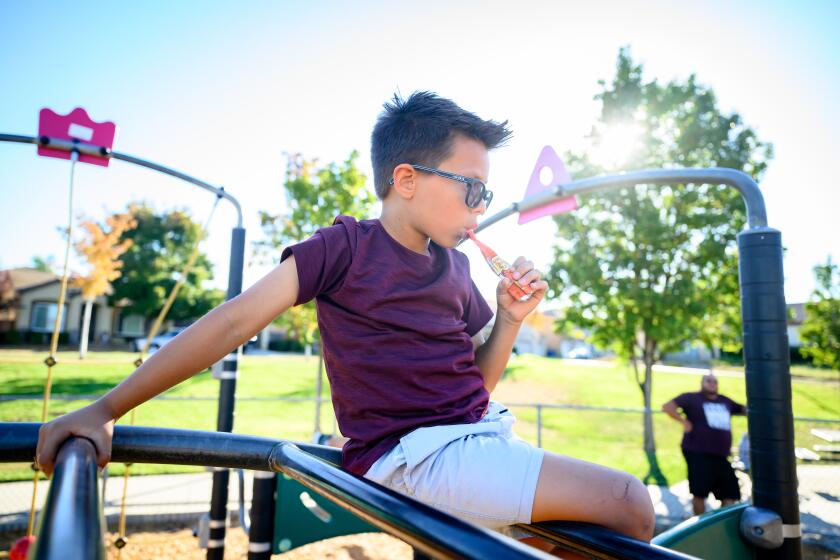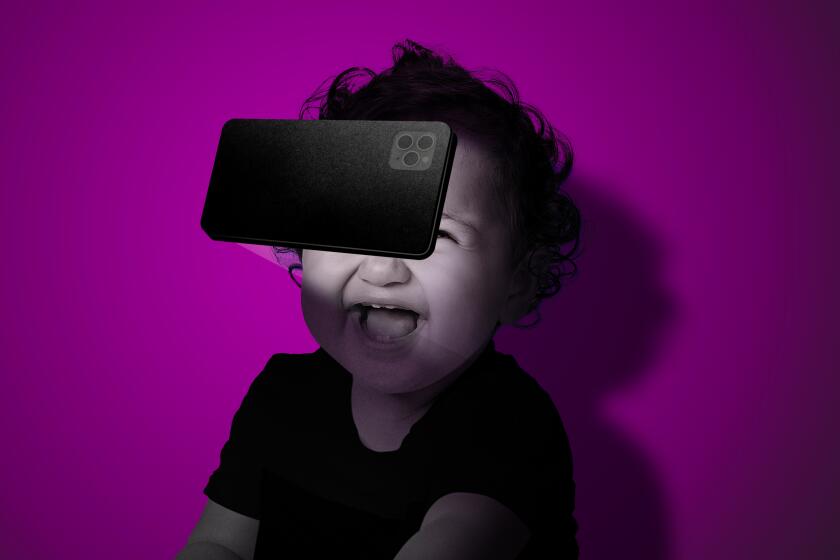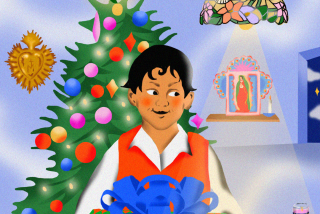How parents tackle the truth behind Santa without ruining the Christmas magic

- Share via
First, Santa spoiler alert! And, parents, you know what we mean.
When Melissa Marion’s 8-year-old son, Johnny, came home from school saying that a classmate had said Santa wasn’t real, she knew just how she wanted to approach it.
“I was like, ‘You know, people believe what they want to believe.’” Marion said, choosing her words carefully. “And he hasn’t brought it up since.”
She wants Johnny to figure out the truth behind Santa on his own, just as she did growing up. And she plans to do the same with his 4-year-old sister as she gets older. It’s fun to pretend the Christmas magic is still alive, she said, and she wants to keep it going as long as possible.
After parents make the holidays magical for their young children, the age of reality can be tricky to navigate. Here’s what experts have to say about the Santa talk.
Engage with our community-funded journalism as we delve into child care, transitional kindergarten, health and other issues affecting children from birth through age 5.
What do you say when a child asks whether Santa is real?
This depends a lot on where a child is developmentally.
Three- and 4-year-olds aren’t likely to question much about the magic, because they tend to be more interested in the end product — Santa’s presents under the tree — rather than the process of how Santa actually got them there.
But by the age of 5 or 6, “children are starting to think about cause and effect,” said Erin O’Connor, a professor of child development at New York University. That’s when they might start questioning the physics of Santa, and asking how exactly a sleigh can travel from the North Pole to their house, or how one bearded man can deliver gifts to millions of kids in a single night.
It’s hard to beat the convenience of baby food pouches. But overreliance can affect a child’s nutrition, food preferences and speech development, experts warn.
But these questions don’t mean they want to learn the truth. Children at this age are still gathering evidence about how the world works and may be asking as a way to confirm that Santa is real. O’Connor suggests that parents turn the inquisition back on their children by asking, “That’s an interesting question. What do you think?”
What is the average age when kids learn the truth about Santa?
Surveys since the 1970s have consistently found that children generally figure out the truth about Santa at 7 or 8. But there is variability. Some 4-year-olds are already telling their parents they don’t believe, while others may hold off for several years beyond.
- Share via
“That’s part of the reason why it can be so difficult for parents to figure out, is it time?” said Candice Mills, a professor of psychology at the University of Texas at Dallas.
Natalie Fairman’s oldest daughter discovered Santa wasn’t real at age 10, when she noticed that the gifts from Santa were the same ones she saw in her mom’s Amazon orders.
What is the right age to tell a child about Santa?
O’Connor said parents should explain the Santa reality by age 8 or 9, which is often when they start getting pushback from peers. “It’s really hard to be one of the only third-graders who still believes, and it’s easier coming from a parent or caregiver than from a peer poking fun of you about it.”
By the time kids are asking directly, “Is Santa really real, or are you actually the one bringing the present?” it’s probably time to fess up, Mills said. “When they’re asking those kinds of questions, usually they really want to know the truth at that point.”
But some parents keep doubling down on Santa, even after the children have been told the truth by peers, leaving their kids to start Googling for answers. When parents take it too far, “it can feel more like a violation,” she said.
Krista Vargas said she will take her son’s lead. If he seems to be a bit skeptical or begins to question inequality among the gifts different kids receive, then, she says, she’ll take it as time to have a deeper conversation. For now as a 16-month-old toddler, he is enjoying the tradition.

Last year, Mills published studies of both adults and children ages 6 to 15 about their belief in Santa in a paper called “Debunking the Santa Myth: The Process and Aftermath of Becoming Skeptical About Santa.” Even though around half of children and adults alike reported feeling some negative emotions such as sadness or anger when they discovered the truth, those feelings tended to be short-lived. About half of children said they actually felt good about discovering the truth — especially those who figured it out themselves.
A few adults surveyed, however, still felt resentful about their parents lying to them. Children who learned the truth later — especially if it didn’t happen until the age of 11 — were more likely to experience only negative emotions about it, according to Mills’ study.
How to explain to kids about Santa?
There’s no one right way to do the big reveal. Mills suggests expanding the joy by telling a child that Santa isn’t just one person — it’s a collective effort of people spreading good deeds, and now the child is old enough to become part of the magic themselves. They might volunteer with their child to drop off gifts for children in need, for example, or help create the magic for a younger child.
In Fairman’s case, that’s been by involving her older daughters in Santa deeds for younger siblings, who are 4 and 6.
Is telling your kids that Santa is real considered a lie?
Imagination, O’Connor said, is an important tool for children to navigate their world. So as long as the holiday myth isn’t used in a manner that takes away the safety and security of imagination, then belief in magic shouldn’t be a problem, O’Connor said.
Many parents allow children more than double the TV and tablet time experts suggest. Families are turning to screens for learning and distraction, clashing with advice.
But don’t assume young children are gullible.
When all of the adults in a child’s life consistently tell them that Santa Claus exists, and then they discover, on Christmas morning, “tangible evidence that Santa Claus exists, why would they doubt it?” said Paul Harris an education professor at Harvard who researches child development.
“We adults have persuaded ourselves that this is one of the bonuses of being a child, that you can revel in magical creatures. But there isn’t much evidence that children are predisposed to magical thinking.”
Still, he said, “I don’t think it does any harm.”
And Mills’ research found reason to think the joy and fun outweigh the negatives in the end: A vast majority of children and adults surveyed still celebrated or planned to celebrate Santa with their own children.
This article is part of The Times’ early childhood education initiative, focusing on the learning and development of California children from birth to age 5. For more information about the initiative and its philanthropic funders, go to latimes.com/earlyed.
More to Read
Sign up for Essential California
The most important California stories and recommendations in your inbox every morning.
You may occasionally receive promotional content from the Los Angeles Times.















